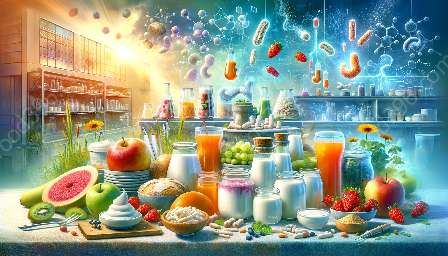Probiotics and prebiotics have garnered increasing attention in the study of food and drink for their potential health benefits. Understanding the mechanisms of action behind these beneficial microorganisms and dietary components is crucial for harnessing their full potential.
What are Probiotics and Prebiotics?
Probiotics are live microorganisms that, when administered in adequate amounts, confer a health benefit on the host. They are commonly found in fermented foods like yogurt, kefir, and kimchi, as well as in dietary supplements. Prebiotics, on the other hand, are non-digestible food ingredients that promote the growth and activity of beneficial microorganisms in the gut, primarily by serving as a substrate for them.
Mechanisms of Action of Probiotics
The mechanisms of action of probiotics encompass a wide range of interactions with the host and the gut microbiota. One key mechanism is the competitive exclusion of pathogenic bacteria. Probiotics can outcompete harmful bacteria for nutrients and colonization sites, thereby reducing the proliferation of pathogenic species.
Additionally, probiotics can modulate the immune system, enhancing the production of anti-inflammatory cytokines and promoting a balanced immune response. They can also strengthen the intestinal barrier, reducing the translocation of harmful substances from the gut into the bloodstream.
- Competitive Exclusion: Probiotics outcompete pathogenic bacteria, reducing their proliferation.
- Immune Modulation: Probiotics enhance anti-inflammatory responses and promote immune balance.
- Intestinal Barrier Strengthening: Probiotics reinforce the gut barrier, preventing harmful substances from entering the bloodstream.
Mechanisms of Action of Prebiotics
Prebiotics exert their effects primarily through the selective stimulation of beneficial gut bacteria. By providing a source of nutrients for these microorganisms, prebiotics promote their growth and metabolic activity, leading to a more favorable gut microbiota composition.
Furthermore, prebiotics can contribute to the production of short-chain fatty acids (SCFAs) in the gut. SCFAs have been associated with numerous health benefits, including anti-inflammatory effects and improved gut barrier function.
- Selective Stimulation: Prebiotics promote the growth and activity of beneficial gut bacteria.
- SCFA Production: Prebiotics contribute to the production of short-chain fatty acids with various health benefits.
Impact on the Study of Food and Drink
Understanding the mechanisms of action of probiotics and prebiotics has significant implications for the study of food and drink. This knowledge can guide the development of functional foods and beverages that are designed to improve gut health and overall well-being.
Food scientists and nutritionists can leverage the mechanisms of action of probiotics and prebiotics to create products that offer targeted health benefits, such as improved digestion, enhanced immune function, and reduced inflammation.
Furthermore, the study of probiotics and prebiotics in the context of food and drink opens up opportunities for innovation in product formulation and marketing. Consumers are increasingly seeking out products that support their health, and the incorporation of probiotics and prebiotics can meet this demand.
Conclusion
Probiotics and prebiotics hold great promise for promoting gut health and overall well-being. Their mechanisms of action, from competitive exclusion and immune modulation to selective stimulation and SCFA production, are central to their beneficial effects.
As the study of probiotics and prebiotics continues to expand, their integration into the field of food and drink presents exciting opportunities for the development of functional and health-promoting products. By understanding and harnessing the mechanisms of action of these microorganisms and dietary components, we can unlock their full potential for improving human health through diet.

